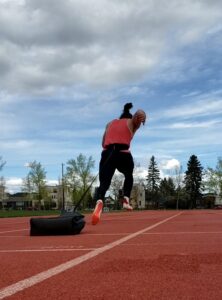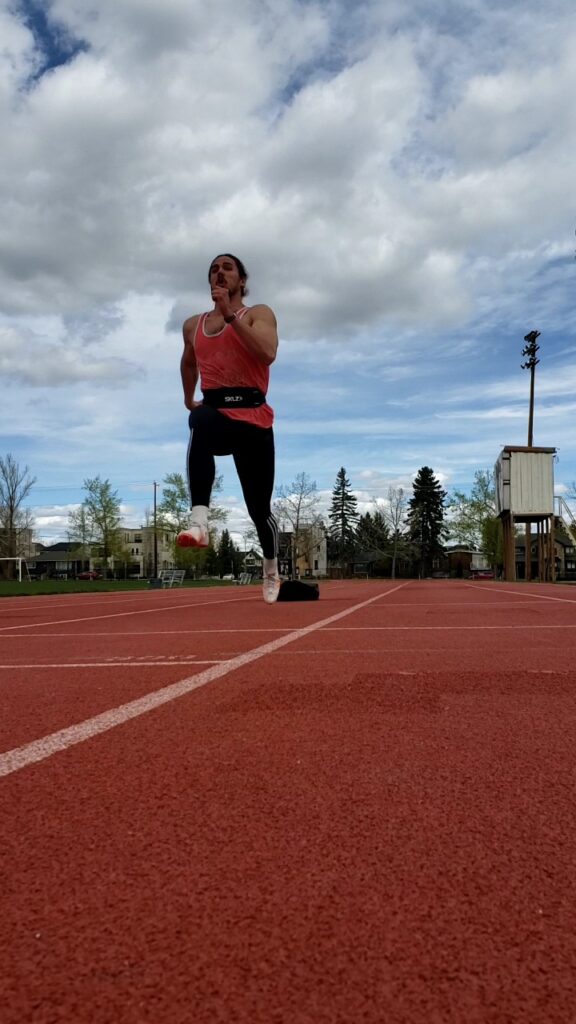Resisted Running – A Tool for Everyone
Resisted running | Typically relegated to sprinting individual athletes, resisted running is a novel method of creating additional demands for running. The academic literature is not entirely sold on whether resisted spriting is helpful for training sprinters, but there has been supporting for the more novice and team sport athletes (1, 2, 3). Being a coach and athlete myself, I have experienced and had success with implementing resisted sprinting at appropriate times – anecdotal experience aside, this is where the art of coaching is critical to determine when and if it is correct.

Let’s cover how we can use a sled to take your fitness and performance to the next level!
Resisted Running Guidelines – Tow Sled
-
Load
- Heavy Loads – 12-45% of body mass or equivalent loss in velocity have improved performance in trained individuals’ ability to accelerate (2).
- Light Loads – <10% of body mass or 10% decrease in velocity. have shown improvements in maximal velocity running (2).
- As running is a motor task, we do not want to deviate too far away from the intended execution of the movements. Adjust the load to enable the best load for the intended training without losing the intended biomechanics.
-
Distance
- The distance will depend on the total load of the sled.
- More significant the load, the shorter the distance.
- 10-30m is recommended by (3), but try playing with longer distances if you want to help with maximal velocity training.
- The distance will depend on the total load of the sled.
-
Intensity
- As close to maximal as you can!
- Your speed will be less, but the intention must be high!
-
Recovery
- Either partial or complete recovery.
- Partial (1:<1-1 work to rest)
- Great for fitness and building capacity.
- Complete (1:1-2+ work to rest)
- Ideal for improving strength and power output.
- Partial (1:<1-1 work to rest)
- Either partial or complete recovery.
-
Total Volume
- 50-200m of the total volume is recommended by (3); however, listen to your body or how an athlete looks.
- Is their technique faltering?
- Can I reproduce the same high-level technique and intensity?
- Better to do one less than one too many!
- 50-200m of the total volume is recommended by (3); however, listen to your body or how an athlete looks.
Cronin, John & Hansen, Keir & Kawamori, Naoki & McNair, Peter. (2008). Effects of weighted vest and sled towing on sprint kinematics. Sports biomechanics / International Society of Biomechanics in Sports. 7. 160-72. 10.1080/14763140701841381. https://www.researchgate.net/publication/5241542_Effects_of_weighted_vest_and_sled_towing_on_sprint_kinematics
Petrakos G, Morin JB, Egan B. Resisted Sled Sprint Training to Improve Sprint Performance: A Systematic Review. Sports Med. 2016 Mar;46(3):381-400. doi: 10.1007/s40279-015-0422-8. PMID: 26553497.https://pubmed.ncbi.nlm.nih.gov/26553497/
Haugen, T., Seiler, S., Sandbakk, Ø. et al. The Training and Development of Elite Sprint Performance: an Integration of Scientific and Best Practice Literature. Sports Med – Open 5, 44 (2019). https://doi.org/10.1186/s40798-019-0221-0 https://rdcu.be/cNQjT
By Troy Wilson
Wilson Kinetic Health
